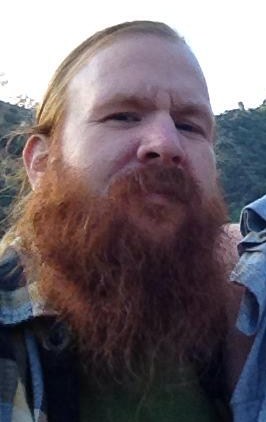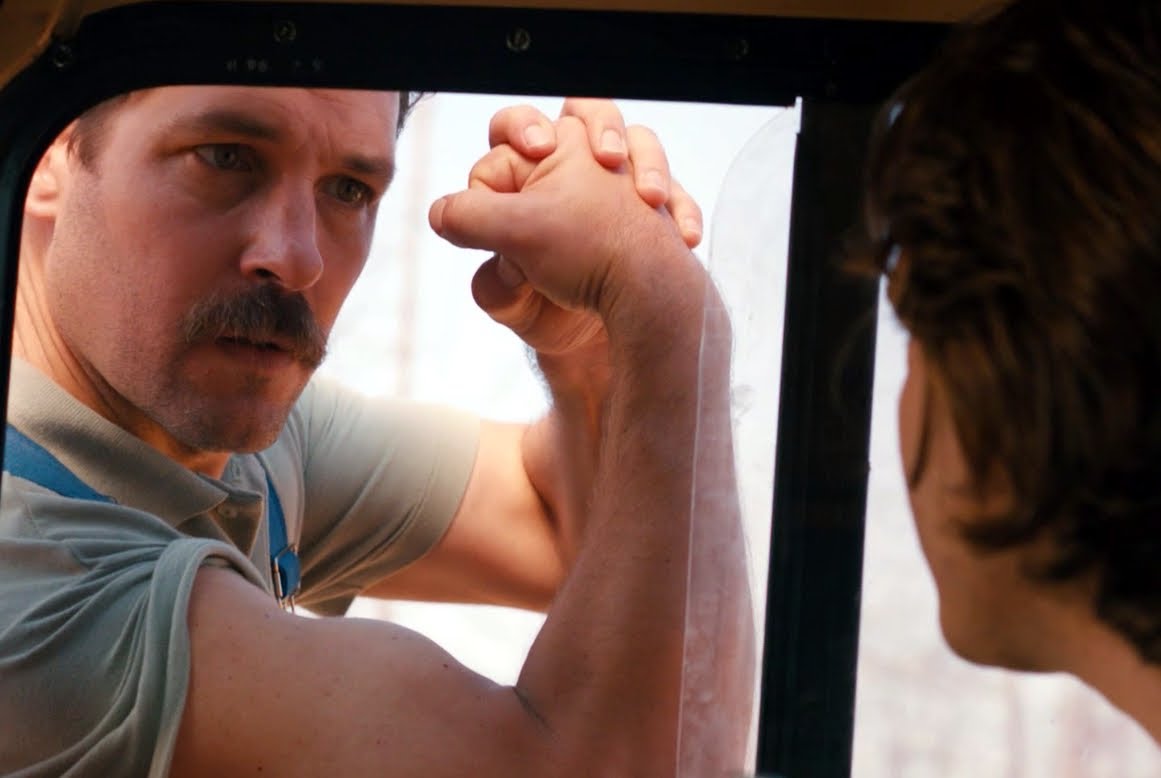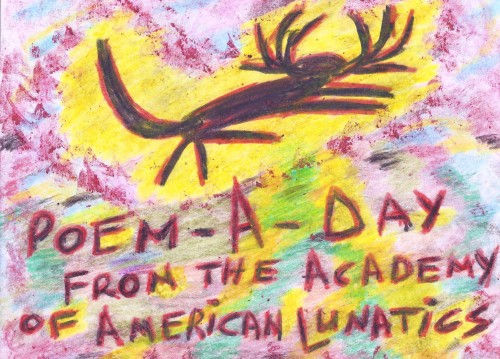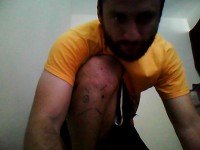….Why Do You Treat Alt Lit (Steve Roggenbuck in particular) with such scorn?…(Ask The Oracle – Part I)….
***
I tend to get lost in the trees so I like to check in with Jereme Dean because well I think of Jereme as a wise man, an oracle, a modern day version of Ikkyū the 15th century Zen Master:
they used sticks and yells and other tricks those fakes
Ikkyū reaches high low like sunlight
Jereme, furthermore, sits outside of writing movements, fashion, allegiances, etc, and there is an authority and a confidence to Jereme that I really respond to:
I live in a shack on the edge of whorehouse row
me autumn a single candle
And because Jereme will tell it you straight, a true oracle, I’ve decided to start up this new feature, “Ask the Oracle,” where, periodically, I’m going to put crucial questions to our modern-day Ikkyū.
***
and so, here then, now, is the first installment of “Ask the Oracle”:
***
Rauan: I’ve seen you poke fun at (or be scornful of, i guess) “Alt Lit” and, specifically, i think, Steve Roggenbuck. But are you really against these positive, energetic DIY youngsters? (& plz elaborate)
Jereme: Alt Lit has nothing to do with online writing, really. It’s a clique. Some have tried desperately to associate writing with the term, like people who feel their worthwhileness is minor and desire to be part of a movement–something remarkable!–or publishers looking to categorize their books for sale. But, don’t be fooled, alt lit is to writing like a cafeteria is to school education.
Internet literature isn’t new. There are plenty of people who’ve been around before the term was coined, and still are around, writing: Blake Butler, Sam Pink, Tao Lin, Daniel Bailey, Mike Young, Jimmy Chen, Brandon Scott Gorrell, etc.
True positivity is anchored and unafraid of negativity, it actually welcomes it. While asserting yourself as a Haitian mongoose, regardless of emphaticism, doesn’t negate being a human being who hates himself/herself.
Unsure where the idea of ‘positivity’ comes from though. I don’t see it. Feel like most people online make great efforts creating a fictitious identity, one which counters their insecurities, and the only way to actually believe the fantasy is to be chill/stay positive/chant affirmations. Because of this, the dissenting voice seems to be enemy number one to alt lit. They react ferociously READ MORE >
December 3rd, 2013 / 8:45 pm
My favorite films of 2013 so far & still in progress
This year, I tried to get caught back up on films. And even though 2013 is far from over, here are my favorites so far:
- A Field in England (Ben Wheatley & Amy Jump)
- Blue Jasmine (Woody Allen)
- Gravity (Alfonso Cuarón & Jonas Cuarón)
- Iron Man Three (Shane Black & Drew Pearce)
- Le joli mai (Chris Marker; revival)
- Museum Hours (Jem Cohen)
- Only God Forgives (Nicolas Winding Refn)
- Prince Avalanche (David Gordon Green, + here’s hoping Paul Rudd is Ant-Man)
- Seven Psychopaths (Martin McDonagh—technically 2012, but I didn’t catch it until this year)
- The Master (Paul Thomas Anderson; ditto)
- The World’s End (Edgar Wright)
- Upstream Color (Shane Carruth)
I have plans to write more about 1, 3, 4, 5, 6, 8, and 12. As well as 9, perhaps. (But not 10.)
+: Godard’s Le mépris is getting a 50th anniversary release, and of course it’s incredible, even though I’m going to miss it this week at the Siskel because I’m stuck grading final papers.
Other new films I’ve seen and enjoyed to varying degrees:
25 Points: Swamp Isthmus
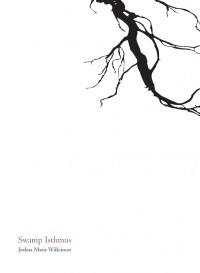 Swamp Isthmus
Swamp Isthmus
by Joshua Marie Wilkinson
Black Ocean, 2013
88 pages / $14.95 buy from Black Ocean
1. I’ve been working on this since this past spring. After reading Beyond The Like Factory & The Hatchet: Rethinking Poetry Reviewing by Joshua Marie Wilkinson, I knew I had to finish this review. This is actually a scary thing to write now.
2. Swamp Isthmus is Joshua Marie Wilkinson’s first book with Black Ocean and the second book in his No Volta pentalogy (first is Selenography, Sidebrow 2010; third will be The Courier’s Archive & Hymnal, Sidebrow 2014). I’ve not read Selenography so there is perhaps some things I’ve missed by not having done so.
3. A swamp is a living-dead landscape; the living feed off of the dead and dying, the most dead areas are filled with the most life and the least dead areas are those with the least life.
From the Hart Crane epigraph (The resigned factions of the dead preside) in the very beginning of Swamp Isthmus, Joshua Marie Wilkinson creates a zombie landscape, a zone that infects the living with symptoms of deadness. In a zombie film this deadness comes to the living with capitalist critiques of our alienating existence, but in Swamp Isthmus we see a zombie that carries critiques of the ecologic and nostalgic sort.
4. The lyrics of Swamp Isthmus are a living-dead endeavor: precise breaks eluding a narrative; linearity reduced to phrases contained in the line.
to disappear you must
tunnel discreet
descrying over nightfall
with unclogged wind
this coast is longer than a train track
needing coarse woolen cloth &
the clothes you’re in
so needing a bad song
to whistle what’s known
but may stick
to another’s mouth
5. Similar to what Zach Savich says about Wilkonson’s lyrics, to kill a zombie takes precision: remove the head, destroy the brain.
6. In The Dead Rustle, The Earth Shudders, Evan Calder Williams points to something that is obvious in Swamp Isthmus:
“…the undead have never really been dead in the first place—they never died.’
7. To cross a swamp takes precision and a mind for the contradiction of the living-dead: step here, not there; eat this, not that; drink plenty of water, but don’t drink the water.
footpaths marked by
false stars
it gathers up in
this bladder of light
8. the trees palsy/ to our bad lines.
9. In some respects, there is an admission with these lines of the failure of poetry to enact this landscape; the lines aren’t good. In some respects it’s proof that poetry works: even the bad lines cause the landscape to shudder.
10. There may be an actual “Swamp Isthmus.” The book’s title might be a reference to Gastineau Channel in Alaska, which at low-tide creates an isthmus from mainland Alaska to Douglas Island. Fritz Cove Road, mentioned in the section, I Go By Edgar Huntly Now, is a road that “dwindles down/to a patch of currants” (note the clever word play on ‘currents’) but it also ends at the place where Gastineau Channel meets Fritz Cove. A place that may eventually be unnavigable by watercraft. A place severely affected by glacial melt/global warming. READ MORE >
December 3rd, 2013 / 5:33 pm
SWARMALERTswarmalert

“Swarming, in other words, maximizes the advantages of formlessness over form…Because such action is self-organizing and self-producing…it is liable to occur spontaneously at all levels of social organization…Not only does Swarm threaten Empire’s monuments and armies…At the level of language, swarming is a sign of poetic activity.”
–Andrew Joron, “Terror Conduction,” The Cry at Zero
Over at Big Lucks, there is a Mike Young poem flapping open with some blankspaces that need filling. The poem is from a chapbook SOON TO COME called Who Can Make It. Maybe it’s a title about survival. Maybe it’s a title about creation. Either way, Big Lucks and Mike Young want you to go visit those blankspaces in Mike Young’s poem with your stormwords, with your birdclouds. Go to the website and fill in the blankspaces and maybe you get a glow shout in the acknowledgments / a chance to be in the newest issue of Big Lucks. Yeah? I think it seems like the kill rhythm. I think it seems like the way to get some colored fumes around here. Winners will be announced on the Big Lucks FB page in January.
Many of these footprints were in large numbers close together and, just by looking quietly at them, men, who themselves originally lived in small hordes, were made aware of the contrast between their own number and the enormous numbers of some animal herds. They were always hungry and on the watch for game; and the more there was of it the better for them. But they also wanted to be more than themselves. Man’s feeling for his own increase was always strong and is certainly not to be understood only as his urge for self-propagation. Men wanted to be more, then and there; the large numbers of the herd which they hunted blended, in their feeling with their own numbers which they wished to be large, and they expressed this in a specific state of communal excitement which I shall call the rhythmic or throbbing crowd.
-Elias Canetti, “Rhythm,” Crowds and Power
POEM-A-DAY from THE ACADEMY OF AMERICAN LUNATICS (#7)
DOG STORY
by Sam Pink
***
there’s this dog that lives a few blocks away from me. i always see him lying down in a fenced-in patio area out back. one time i saw a guy walking his dog by the fenced-in patio area and the guy stopped and stood there distracted–talking on his cellphone–as his dog pissed on the head of the dog lying down, who didn’t move.
***
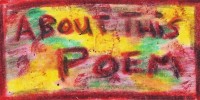
i wrote this poem after rauan asked me if i had any poems. the main inspiration is a dog i saw getting pissed on, and also, rauan asking me for a poem.
![]()
note: I’ve started this feature up as a kind of homage and alternative (a companion series, if you will) to the incredible work Alex Dimitrov and the rest of the team at the The Academy of American Poets are doing. I mean it’s astonishing how they are able to get masterpieces of such stature out to the masses on an almost daily basis. But, some poems, though formidable in their own right, aren’t quite right for that pantheon. And, so I’m planning on bridging the gap. A kind of complementary series. Enjoy!
December 2nd, 2013 / 9:21 pm
Cyber Monday Sale
“Give the Gift of Poetry this Holiday Season”
35% off everything including Langston Hughes Notebooks, Emerson Necklaces, Rumi Calendars, Iambic Pentameter T-shirts, etc, etc,..
go to to Poets.org (The Academy of American Poets) and use the code POETS35OFF to get your discount
…and Hurry!
Favorite Books Read During 2013
December already?? A brief & informal list of some of my favorite books read during the year 2013 (not necessarily published in 2013).
***
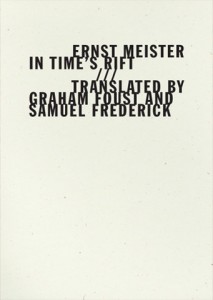 In Time’s Rift by Ernst Meister (Wave Books, 2012)
In Time’s Rift by Ernst Meister (Wave Books, 2012)
Translated by Graham Foust and Samuel Frederick
This,
the familiar,
will eternally be
an unknown to you;
anyway, you’re no longer
known to yourself.
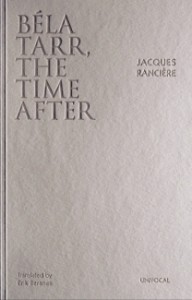 Béla Tarr, The Time After by Jacques Rancière (Univocal Publishing, 2013)
Béla Tarr, The Time After by Jacques Rancière (Univocal Publishing, 2013)
Translated by Erik Beranek
“We cannot identify ourselves with their feelings. But we enter into something more essential, into the very duration at the heart of which things penetrate and affect them, the suffering of repetition, the sense of another life, the dignity assumed in order to pursue the dream of this other life, and to bear the deception of this dream.”
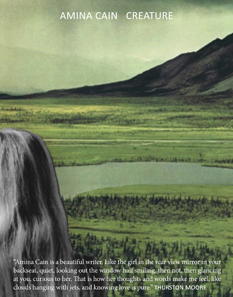 Creature by Amina Cain (Dorothy, A Publishing Project, 2013)
Creature by Amina Cain (Dorothy, A Publishing Project, 2013)
“When I got home, my partner was eating an egg. This is what he does when I’m not around. He also eats fish. I was harsh to him, but without speaking. I expressed myself through the violent putting away of a pan. Later I saw on his lap and dreamed about the future. This was together alone.”
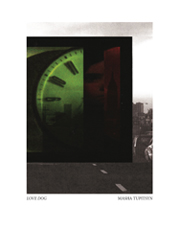 Love Dog by Masha Tupitsyn (Penny-Ante Editions, 2013)
Love Dog by Masha Tupitsyn (Penny-Ante Editions, 2013)
“My ears have been hearing things, things which aren’t even words, or messages, while my eyes, along with everyone else’s, are forever telling me that nothing is here. That nothing is happening. It is the difference between inward and outward. Between me and everyone else.”
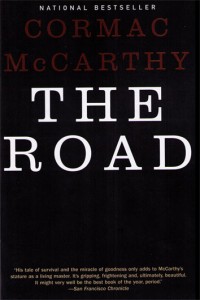 The Road by Cormac McCarthy (Vintage Books, 2007)
The Road by Cormac McCarthy (Vintage Books, 2007)
“He walked out in the gray light and stood and he saw for a brief moment the absolute truth of the world. The cold relentless circling of the intestate earth. Darkness implacable. The blind dogs of the sun in their running. The crushing black vacuum of the universe. And somewhere two hunted animals trembling like ground-foxes in their cover. Borrowed time and borrowed world and borrowed eyes with which to sorrow it.”
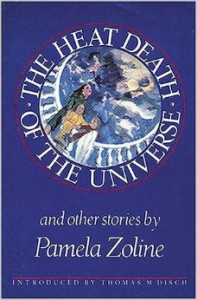 The Heat Death of the Universe and Other Stories by Pamela Zoline (Mcpherson & Co, 1988)
The Heat Death of the Universe and Other Stories by Pamela Zoline (Mcpherson & Co, 1988)
“2. Imagine a pale blue sky, almost green, with clouds only at the rims. The earth rolls and the sun appears to mount, mountains erode, fruits decay, the Foraminifera adds another chamber to its shell, babies’ fingernails grow as does the hair of the dead in their graves, and in egg timers the sands fall and the eggs cook on.”
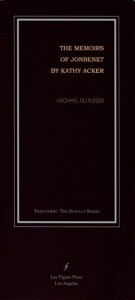 The Memoirs of JonBenet by Kathy Acker by Michael du Plessis (Les Figues Press, 2012)
The Memoirs of JonBenet by Kathy Acker by Michael du Plessis (Les Figues Press, 2012)
I’m afraid we’re inventing something that isn’t there.
Why is sex with you another blank?
Waiting, as you consider it, is fine but there comes a moment when the conditions you impose outweigh any present emotions. “I can’t be with you until…” translates into “I can’t be with you until caution becomes indifference.” Yes, as you say over and over again, you’ve made me feel again; truly, I do feel again, enough to be able to tell you that I’m only telling myself that I feel with you.
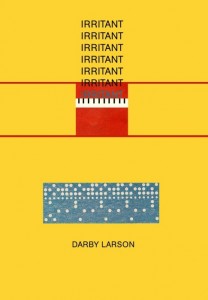 Irritant by Darby Larson (Blue Square Press, 2013)
Irritant by Darby Larson (Blue Square Press, 2013)
“In something of red lived an irritant. Safe from the blue from the irr. And this truck went in it. Safe. Something of red in it back to the blue to the red. This truck and something extra. Listen. The nearby something extras in front of the truck. The man in front of the truck trampled from front to back safe from the blue. And all this while the man scooped shovels of dirt and trampled from front to back front to back.”
 Anna Patova Crosses a Bridge by Renee Gladman (Dorothy, A Publishing Project, 2013)
Anna Patova Crosses a Bridge by Renee Gladman (Dorothy, A Publishing Project, 2013)
For one second, I spoke “sentence,” which confused her, since all this time I’d been saying “paragraphs.” It was a moment of our mouths missing one another. Her mouth was emitting sound. She seemed to be calling my name, breathing heavily, she seemed to put her words inside me. “Writing my frightening paragraphs,” I said, involuntarily.
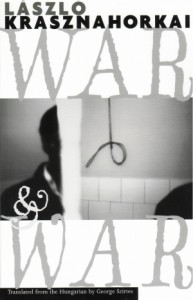 War and War by László Krasznahorkai (New Directions, 2006)
War and War by László Krasznahorkai (New Directions, 2006)
Translated by George Szirtes
“I no longer care if I die, said Korin, then, after a long silence, pointed to the nearby flooded quarry: Are those swans?”
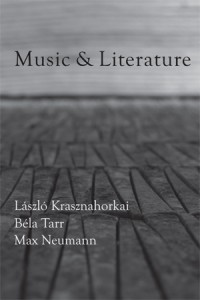 Music & Literature Issue 2: Krasznahorkai / Tarr / Neumann (Spring 2013)
Music & Literature Issue 2: Krasznahorkai / Tarr / Neumann (Spring 2013)
From “About a Photographer” by Lászlo Krasznahorkai (Translated by George Szirtes):
“Condemned to look, yet at the same time to be deprived of sight, we are in a complex pitiless trap, a double cage, to the recognition of which—though it cages us all—fate condemns confusingly few. In any case those who do suffer the agonizing moment of recognition could easily be consumed by an all-but fatal melancholy, so it’s no wonder they try to struggle free, their first recourse on their dire necessity being the thought of some device.”
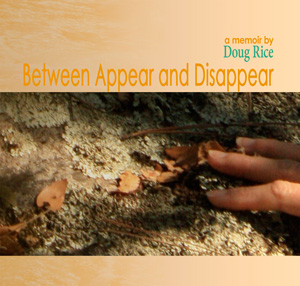 Between Appear and Disappear by Doug Rice (Jaded Ibis Press, 2013)
Between Appear and Disappear by Doug Rice (Jaded Ibis Press, 2013)
“I want to find a sentence that in the making becomes a resurrection. Our skin marked by the remains of language from childhood dreams near the river. The Allegheny. The Monongahela. The Ohio. This trinity of cold rivers that demand that we never forget to forgive.”
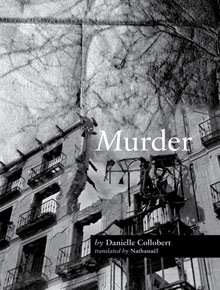 Murder by Danielle Collobert (Litmus Press, 2013)
Murder by Danielle Collobert (Litmus Press, 2013)
Translated by Nathanaël
“It’s strange this encounter with the internal eye, behind the keyhole, that sees, and finds the external eye, caught in flagrante delicto of vision, curiosity, uncertainty. The one that looks out, to see outside itself, what is happening in the world, perhaps, or inside itself, this eye, doesn’t know whether it’s looking into the emptiness, into the air, into the other, or into a distance landscape, which it brought to like, like a memory, a wanted decor, chosen, an elemental power, that could be the background of its life.”
The Day Irony Stood Still: On Thomas Pynchon’s Bleeding Edge
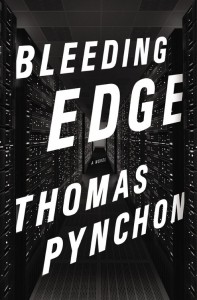 Bleeding Edge
Bleeding Edge
by Thomas Pynchon
Penguin Press HC, Sept 2013
496 pages / $28.95 Buy from Amazon or Indiebound
“I met a lot of hard-boiled eggs in my life, but you — you’re twenty minutes.” — Lorraine Minosa, Ace in the Hole (1951)
The appeal of the hard-boiled character archetype is their indefatigable coolness, their aloofness. We seem to like characters who react in seemingly inhuman ways to moments and situations in which the rest of us would be too consumed by nerves or emotions to construct a sentence, let alone a biting bit of wordplay. These characters are mostly at home in the dimly lit offices and back alleyways of the film noir detective, but we see permutations of the archetype every time we encounter a dominant lead with a penchant for mouthing off to baddies with guns.
Hard-boiled works best with snoops, and Thomas Pynchon has veered his career into continuing to explore the limits of this character type, setting up camp everywhere from the Revolutionary War (Mason & Dixon) to 1980’s California (Vineland) with a cast of irreverent characters who never cease to check the self-importance of not only their verbal sparring partners, but of moments themselves.
But what Pynchon has chosen to explore in Bleeding Edge, his seventh novel, is what would happen if you took all of those Pychonian elements of irony and placed them in a time and place in which it didn’t stand out, and was, in fact, par for the course.
Maxine Tarnow, a rogue (or at least de-licensed) fraud investigator and single-ish (it’s complicated) mother of two, plays the part of our protagonist. She is, as teh novel opens, approached by Reg Despard, a filmmaker acquaintance, to look into the finances of a shady enterprise called hashlingrz, a deep-pocketed Internet company buying up infrastructure and failed start-ups that went under after the .Com bubble burst, a fate which hashlingrz itself somehow sidestepped. From there, we begin to fall headlong into lengthy list of classic noir tropes: the numbers that don’t add up, the seedy-yet-likable characters of the city’s underbelly, the overseas connections, and yes, even an homme fatale. New York City looms large (doesn’t it always?) as the book’s backdrop, not simply because of Pynchon’s love for it — Bleeding Edge is an unashamed love letter to the city — but because of what we all know to be coming: the book begins in March of 2001, and will lead us by the hand through nearly a year, including, of course, 11 September. If there’s reason to question Pynchon’s decided lack of in-depth development for any of the book’s other characters, it’s because New York itself is our secondary — or perhaps even primary — protagonist, itself “twenty minutes” in hot water.
Maxine, in all her hard-boiled glory, is Pynchon’s representation of irony incarnate, not that other sources aren’t otherwise readily available. But it’s through her that the book drives home it’s final point re:the death or non-death of irony, which is that 11 September did not kill irony, a claim that has manifested itself countless times in the last twelve odd years. What it did was remind us that irony doesn’t work all of the time, and for it to retain its bite, you have to allow for moments of fear and sincerity and bravery, not to mention silence. “For many people, especially in New York,” Pynchon jabs, “laughing is a way of being loud without having to say anything.”
When discussing postmodernism in general, and Pynchon in particular, these days, irony is the word burning on every tongue of every critic/commentator, easily the most vilified and misused word of the past decade and a half.
It’s nearly impossible to discuss postmodern irony without making reference to “E Pluribus Unum: Television and U.S. Fiction”, the ubiquitous essay by the late David Foster Wallace that decried mass culture’s co-option and subsequent neutering of irony, and proposed a revival of sincerity.
“The next real literary ‘rebels’ in this country might well emerge as some weird bunch of anti-rebels,” Wallace wrote, “born oglers who dare somehow to back away from ironic watching, who have the childish gall actually to endorse and instantiate single-entendre principles. Who treat of plain old untrendy human troubles and emotions in U.S. life with reverence and conviction. Who eschew self-consciousness and hip fatigue.
While a new group of authors, Wallace, Franzen, Safran Foer et. all, ushered in a new era of sincerity in high art, the true cultural rot that Wallace had warned against wasn’t happening in lit mags, but quietly on the lower rungs of the cultural ladder. Most people took DFW’s essay as a grand metaphor for literature, but anyone with any cursory biographical knowledge of Wallace would know that he loved, to the point of addiction, bad television. And it was here that Wallace saw the writing on the wall. The Mark Leyners of the world were never the problem. Literature was too diffuse even then to really have the sort of devastating societal ramifications that Wallace foretold; but if you lose sincerity in “low” art, when it embraces what it is and no longer holds any pretensions about maybe passing as the “real” thing, and when it multiplies like wildfire, you’re doomed.
““Ain’t like I was ever Alfred Hitchcock or somethin,” Maxine’s filmmaker friend/client-pro-bono Reg admits proudly. “You can watch my stuff till you’re cross-eyed and there’ll never be any deeper meaning. I see something interesting, I shoot it is all. Future of film if you want to know—someday, more bandwidth, more video files up on the Internet, everybody’ll be shootin everything, way too much to look at, nothin will mean shit. Think of me as the prophet of that.”
December 2nd, 2013 / 12:00 pm
Collateral Light by Julia Cohen
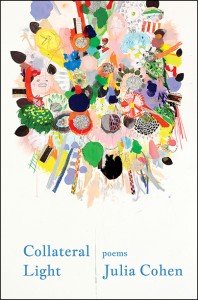 Collateral Light
Collateral Light
by Julia Cohen
Brooklyn Arts Press, Oct 2013
94 pages / $15.95 Buy from BAP or SPD
On the first page of “No One Told Me I Was the Arrow”, Julia Cohen writes:
a life
of sea-
sickness
dreaming of ships
An insect
on snow
At the limit
of our
body
a brief spasm
of laurels
Caught, sickness, limit, spasm. No one told her. In this, the first poem in Collateral Light‘s first section, Cohen seems to be setting forth an aesthetic program both in her subject matter and in the laconic precision of her style: To move over the frozen terrain of an aestheticized life, practicing an insect-like lightness and thereby avoiding falling into the ‘snow’. This is not, in itself, an unadmirable pursuit. It is also one to which poetry is particularly well-adapted–is there any medium more capable of lambently exploring ‘the limit/of our/body’ without becoming mired? And yet perhaps I can be forgiven that my heart dipped in my chest at the prospect of another book devoted to elegies on the subject of inability and asymptotes. It therefore came as both a surprise and a relief when Cohen discards her regretful tone at the poem’s conclusion:
my point
plunge
into a glass
of soil
“An insect/on snow” nothing, O me of little faith. Cohen is ready and able to dive within. In Collateral Light, we have the pleasure of going with her.
Over course of the poems following this introduction, Cohen delivers on the promise vested in the conclusion of “No One Told Me I Was The Arrow”. Her writing revolves around shifts, mutations, permanence, lability. Certain terms recur with such regularity that they become fraught, even overloaded, with meaning. Arrows (those symbols of both indication and entry) appear again and again, both negatively (“My pixels/deflect arrows”) and positively (“I’m filled/with invisible arrows”). Coats, husks and shells are shedded or pierced, disrupting the boundaries between the within and without of a given person (as when she writes, “Kiss my puppy lips my deer lips/the animal inside that animal/alive & yelping through the skin”). The introduction or relaxation of this confusion is at the center of many of Cohen’s more arresting passages, such as in the eponymous poem’s opening lines:
inside your face
& look down
at the sunken garden
My toes are cute
My packet of
bees comes in
Spreading whiteness, imperfect memory, gardens (be they sunken, frozen, night-, or made up of “Fake flowers burst forth from fake seeds”), ice, frost, veins, circulation and filtration. The throughlines multiply without compromising the slow, considered style. Cohen knows how to play to the strengths of that style; this is perhaps best-displayed by the particularly wonderful “The Decoy Museum Is Still”, in which sparse lines such as, “You walk into a stranger’s dirty pocket of air,” seize attention through their quiet profundity.
Cohen deserves to be lauded for what she is doing, but it’s nonetheless worth noting what she avoids doing. Her poems are both active and interactive, and yet possess none of the common signifiers that contemporary readers might associate with such terms. The rhythm is not argot-conversational or rat-a-tat percussive; the verses are not fit to bursting with pop-culture bricolage; there is no compulsive disgorging of confessional factoids. Cohen engages the reader through the steady application of precise language, carefully maintained across the length of each individual work. She never abandons her mode in favor of spasmodically gesturing beyond the limits of comprehensibility. If it seems like I’m belaboring the point, here, it’s because it’s a point that could stand a little belaboring: In a time when contemporary poetry is frequently (and unfairly) pigeonholed as belonging to either a hermetically classicistic tradition or a hypermodern, glossolalic movement, Cohen does not allow herself to be lumped in with either.
December 2nd, 2013 / 12:00 pm
Natural History of Asphalt by Anthony Seidman
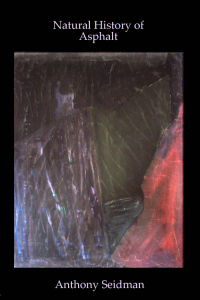 Natural History of Asphalt
Natural History of Asphalt
by Anthony Seidman
Oneiros Books, 2013
116 pages / $9.98 Buy from Oneiros Books
The prose poems of Anthony Seidman’s Natural History of Asphalt are every bit as hard as the “vast and ugly” avenues of North Hollywood – the San Fernando Valley town where the poet makes his home. They are dark as pitch but, under a certain slant of light, they shimmer. They rise from the Valley’s potholed roads and parking lots, which reverberate with paved-over scars and traumas, like waves of refracted light in the blazing desert heat: “Sunday, the San Fernando Valley is a plain of empty parking lots, with the Tongva gone, bones under the macadam. Their women of ochre-smeared faces now dance and feast in the underworld. Their men hunt ghost deer. All the juniper-berries they desire. All the yucca and jackrabbit.”
Like these parking lots, in a country where every day is a travesty of summer, the poems are hot to the touch, even blistering. In one of the most powerful pieces in this collection, a young Latino boy runs to a corner store for a Hershey bar, scorching his tender bare feet: “I set the boy down and hold up his feet to see the damage; his soles are now two blisters, in parts parchment yellow, in other parts translucent sheaves of epidermis. One blister rupture, mustard colored plasma oozes thick as penicillin.” At the end, when the boy is being carted away in a Fire Department ambulance, the poet finds himself unwittingly – but wholeheartedly – adopting the injured and frightened child. These poems call us to adopt what we never intended to own – towns seemingly scrubbed of any real humanity, full of circumspect strangers with whom we haven’t a word in common. But a living heart beats beneath the asphalt, and “Christmas lights flicker over the bar-top.” We are surprised by a pride of place: “These foothills, chaparral, are my country, these gas stations, these sub-par public schools, vacant lots and miles of asphalt… they are the sigil I behold through smog.”
This proud peace, at which the poet arrives after long nights at the Hotel Insomnia, grants him a relief from the despair of those for whom language is more than hard currency. For Seidman, words are synesthetic sore spots, triggering waves of sensations that flow out and fade into the bleak landscape: “In my glossolalia, the word emerald is glacial. Cold and chiseled, not from elms, but from ice so cold it’s flecked with green under crystalline sunlight, For some reason, I see black wood and suji screens, odor of tea steaming in the syllables, suzerain.” These transcendent associations clink against the unambiguous glare of neon, against the “metal shop and junkyard.” “Un-sense me,” the poet demands, “and scent me a language like thumping a club against dung.”
But the story of Natural History is one of reconciliation, the recognition of the transcendent in the cold light: “When the unemployment check arrives, my mouth puckers dry; I look west and see the cobalt neon tubes shaped like a crab, and the cerulean word: MARISCOS.” He is drawn here for “one thing, the way a widow goes to the shore to see the waves swell then dissolve on the same, like pain swelling, then ebbing.” But he is not alone – he is among men who “remember gold that glitters beneath darker currents.” And when we realize with the poet that “All of us are marooned here,” at the landlocked bar Las Playas, the taste of loneliness, which is “acrid, aspirin on the tongue,” slowly melts away.
***
Boris Dralyuk teaches Russian literature at UCLA and has translated several collections of poetry and prose from Russian and Polish. He received first prize in the 2011 Compass Translation Award competition and, with Irina Mashinski, first prize in the 2012 Joseph Brodsky / Stephen Spender Translation Prize competition. He is co-editor, with Robert Chandler and Irina Mashinski, of the forthcoming Anthology of Russian Poetry from Pushkin to Brodsky (Penguin Classics, 2014).
***
An abbreviated version of this review appeared in Ragzine.cc.
December 2nd, 2013 / 12:00 pm

